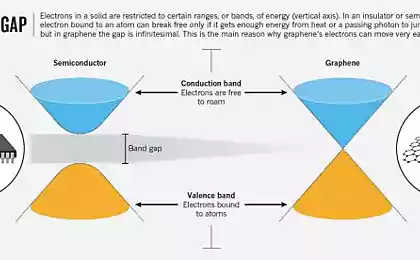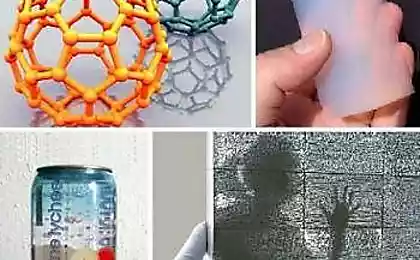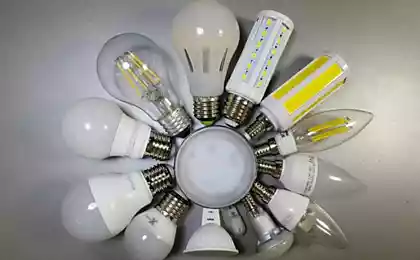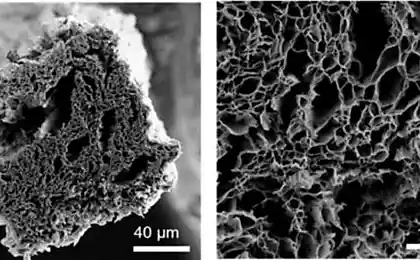436
Created the first transparent OLED display with graphene electrodes
Flexible, transparent and extremely strong, graphene is an excellent conductor of heat and electrical current, making this material one of the most promising candidates for its use in next generation electronic devices.
Not so long ago researchers from the Institute for Organic electronics, electron beam and plasma technology Fraunhofer (Fraunhofer Institute for Organic Electronics, Electron Beam and Plasma Technology FEP), Germany, has created a first of its kind, transparent OLED display, all inside of which the electrodes are made of graphene. And this achievement opens the way to developing a number of new components and devices, including flexible and transparent touch screens, various sensors and elements high-efficiency solar panels.

Electrodes, connecting a matrix of light-emitting elements based on organic LEDs (OLED, organic light-emitting display), cover the area with a size of 2 by 1 centimeter. They were created through a process of chemical vapor deposition (chemical vapor deposition, CVD), which uses a chamber with an atmosphere of methane and hydrogen, and the copper plate heated to a temperature of 800 degrees Celsius.
On the surface of the copper plate, which acts as a catalyst, a chemical reaction takes place, during which the broken down molecules of methane. Emitted while carbon atoms are deposited on the copper surface and form the graphene layer of monatomic thickness. To complete the formation of the graphene film it all cooled down and on the surface of the graphene is applied to a polymer protective layer serves as a transparent Foundation for the future of the display. The resulting two-layer structure separated from the base and it chemically removes residues of copper, after which the polymer base is a layer of pure graphene the required forms and sizes.

It should be noted that German scientists created the display is the first display with graphene electrodes, but it is the first that uses OLED technology. And this technology, as is well known, allows you to create screens full color with high contrast, colour reproduction and fast response time.
"The first commercial products based on technologies developed by our company can be on the market in two to three years," says Dr. Beatrice Beyer (Beatrice Beyer), head of the project. And work in the framework of the project carried out by employees of the Fraunhofer Institute together with employees of the Spanish company Graphenea S. A. and the British company Aixtron Ltd., which produced a new type of reactor for the process of chemical vapor deposition graphene. published
Source: newatlas.com/graphene-oled-display-fraunhofer/47318/
Not so long ago researchers from the Institute for Organic electronics, electron beam and plasma technology Fraunhofer (Fraunhofer Institute for Organic Electronics, Electron Beam and Plasma Technology FEP), Germany, has created a first of its kind, transparent OLED display, all inside of which the electrodes are made of graphene. And this achievement opens the way to developing a number of new components and devices, including flexible and transparent touch screens, various sensors and elements high-efficiency solar panels.

Electrodes, connecting a matrix of light-emitting elements based on organic LEDs (OLED, organic light-emitting display), cover the area with a size of 2 by 1 centimeter. They were created through a process of chemical vapor deposition (chemical vapor deposition, CVD), which uses a chamber with an atmosphere of methane and hydrogen, and the copper plate heated to a temperature of 800 degrees Celsius.
On the surface of the copper plate, which acts as a catalyst, a chemical reaction takes place, during which the broken down molecules of methane. Emitted while carbon atoms are deposited on the copper surface and form the graphene layer of monatomic thickness. To complete the formation of the graphene film it all cooled down and on the surface of the graphene is applied to a polymer protective layer serves as a transparent Foundation for the future of the display. The resulting two-layer structure separated from the base and it chemically removes residues of copper, after which the polymer base is a layer of pure graphene the required forms and sizes.

It should be noted that German scientists created the display is the first display with graphene electrodes, but it is the first that uses OLED technology. And this technology, as is well known, allows you to create screens full color with high contrast, colour reproduction and fast response time.
"The first commercial products based on technologies developed by our company can be on the market in two to three years," says Dr. Beatrice Beyer (Beatrice Beyer), head of the project. And work in the framework of the project carried out by employees of the Fraunhofer Institute together with employees of the Spanish company Graphenea S. A. and the British company Aixtron Ltd., which produced a new type of reactor for the process of chemical vapor deposition graphene. published
Source: newatlas.com/graphene-oled-display-fraunhofer/47318/
What are the opportunities of the global geothermal industry?
Honda will introduce a new hybrid vehicle in 2018























